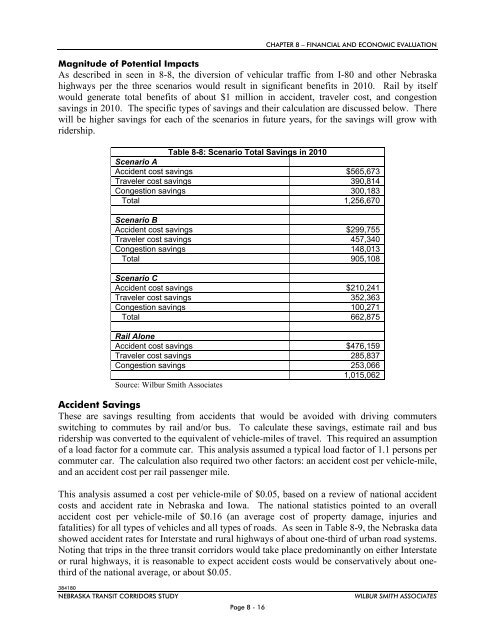NTRAC Final Study - Nebraska Department of Roads - State of ...
NTRAC Final Study - Nebraska Department of Roads - State of ...
NTRAC Final Study - Nebraska Department of Roads - State of ...
Create successful ePaper yourself
Turn your PDF publications into a flip-book with our unique Google optimized e-Paper software.
CHAPTER 8 – FINANCIAL AND ECONOMIC EVALUATION<br />
Magnitude <strong>of</strong> Potential Impacts<br />
As described in seen in 8-8, the diversion <strong>of</strong> vehicular traffic from I-80 and other <strong>Nebraska</strong><br />
highways per the three scenarios would result in significant benefits in 2010. Rail by itself<br />
would generate total benefits <strong>of</strong> about $1 million in accident, traveler cost, and congestion<br />
savings in 2010. The specific types <strong>of</strong> savings and their calculation are discussed below. There<br />
will be higher savings for each <strong>of</strong> the scenarios in future years, for the savings will grow with<br />
ridership.<br />
Table 8-8: Scenario Total Savings in 2010<br />
Scenario A<br />
Accident cost savings $565,673<br />
Traveler cost savings 390,814<br />
Congestion savings 300,183<br />
Total 1,256,670<br />
Scenario B<br />
Accident cost savings $299,755<br />
Traveler cost savings 457,340<br />
Congestion savings 148,013<br />
Total 905,108<br />
Scenario C<br />
Accident cost savings $210,241<br />
Traveler cost savings 352,363<br />
Congestion savings 100,271<br />
Total 662,875<br />
Rail Alone<br />
Accident cost savings $476,159<br />
Traveler cost savings 285,837<br />
Congestion savings 253,066<br />
1,015,062<br />
Source: Wilbur Smith Associates<br />
Accident Savings<br />
These are savings resulting from accidents that would be avoided with driving commuters<br />
switching to commutes by rail and/or bus. To calculate these savings, estimate rail and bus<br />
ridership was converted to the equivalent <strong>of</strong> vehicle-miles <strong>of</strong> travel. This required an assumption<br />
<strong>of</strong> a load factor for a commute car. This analysis assumed a typical load factor <strong>of</strong> 1.1 persons per<br />
commuter car. The calculation also required two other factors: an accident cost per vehicle-mile,<br />
and an accident cost per rail passenger mile.<br />
This analysis assumed a cost per vehicle-mile <strong>of</strong> $0.05, based on a review <strong>of</strong> national accident<br />
costs and accident rate in <strong>Nebraska</strong> and Iowa. The national statistics pointed to an overall<br />
accident cost per vehicle-mile <strong>of</strong> $0.16 (an average cost <strong>of</strong> property damage, injuries and<br />
fatalities) for all types <strong>of</strong> vehicles and all types <strong>of</strong> roads. As seen in Table 8-9, the <strong>Nebraska</strong> data<br />
showed accident rates for Interstate and rural highways <strong>of</strong> about one-third <strong>of</strong> urban road systems.<br />
Noting that trips in the three transit corridors would take place predominantly on either Interstate<br />
or rural highways, it is reasonable to expect accident costs would be conservatively about onethird<br />
<strong>of</strong> the national average, or about $0.05.<br />
384180<br />
NEBRASKA TRANSIT CORRIDORS STUDY<br />
Page 8 - 16<br />
WILBUR SMITH ASSOCIATES

















